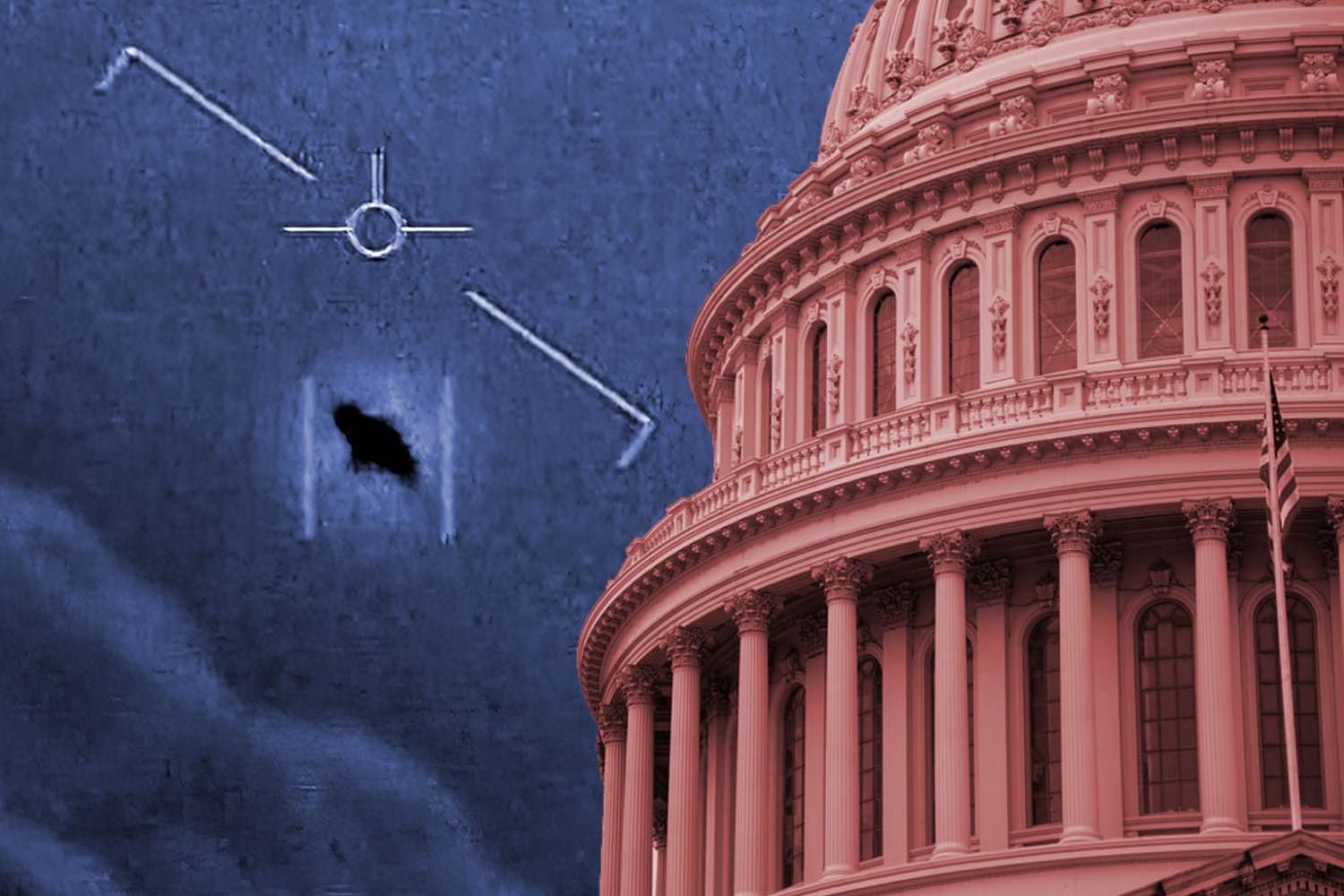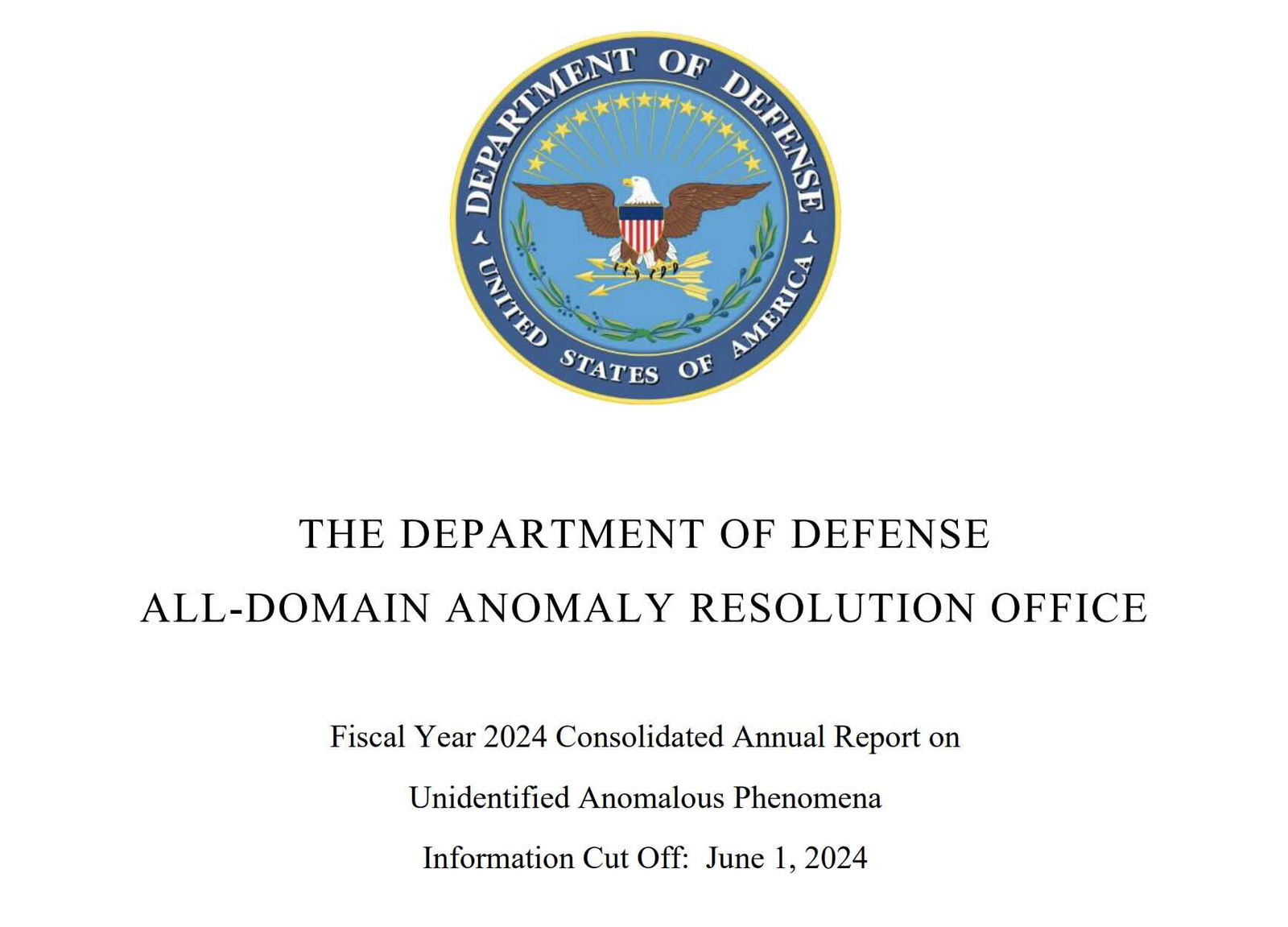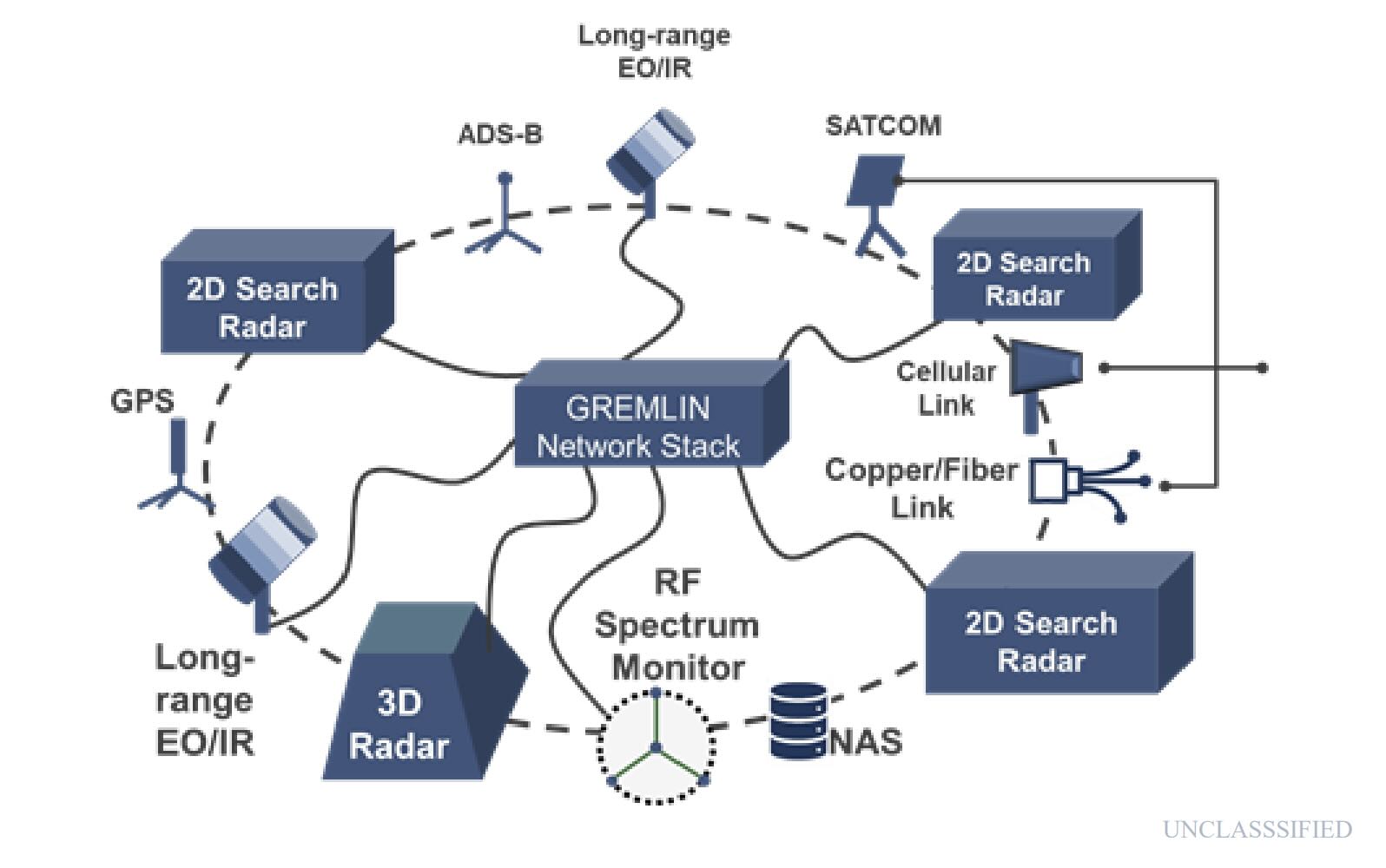

Welcome to this week’s double-sized installment of The Intelligence Brief… today, the DoD released its 2024 annual report on Unidentified Anomalous Phenomena (UAP), within 24 hours of the conclusion of a Congressional hearing on the topic. In our analysis of this week’s UAP double-hit combo, we’ll be looking at 1) significant takeaways from the latest official report on the DoD’s UAP investigations, 2) trends reported by the DoD’s All-domain Anomaly Resolution Office (AARO), and then shifting gears, we’ll examine 3) what former officials told lawmakers on Capitol hill yesterday involving UAP and 4) how claims involving secret U.S. programs and Pentagon disinformation campaigns became a major focal point of yesterday’s hearing.
Quote of the Week
“Let me be clear: UAP are real. Advanced technologies not made by our government—or any other government—are monitoring sensitive military installations around the globe.”
– Luis Elizondo
Latest News: In recent news from The Debrief, Avi Loeb provides an update on the release of the Galileo Project’s commissioning data from its first Observatory at Harvard University in a new scientific paper. Elsewhere, tiny “hurricanes of light” could revolutionize the transmission of information in a process described as “halfway between order and chaos.” You’ll find links to all our recent stories at the end of this week’s newsletter.
Podcasts: In podcasts this week, on the latest installment of The Debrief Weekly Report, Kenna and Stephanie decide to take a dip in a Martian ocean and discuss China’s Mars expedition and its discovery. Meanwhile on The Micah Hanks Program, I provide a deep-dive in to this week’s Congressional UAP hearing. You can find all our past episodes on The Debrief’s Podcasts Page.
Video News: On the latest episode of Rebelliously Curious, Chrissy Newton takes a critical look at the rise of misinformation, manipulation, and cult-like followings in UFO culture. Be sure to check out other great content from The Debrief on our official YouTube Channel.
With all that out of the way, it’s time to dive into the DoD’s latest report on its ongoing investigations into unidentified anomalous phenomena and what a group of lawmakers said about the topic during a congressional hearing earlier this week.
The DoD Just Dropped Its Latest UAP Report
On Thursday, the DoD released the Fiscal Year 2024 Consolidated Annual Report on Unidentified Anomalous Phenomena, the Pentagon’s latest official annual installment detailing its progress in studying and evaluating unusual phenomena encountered by U.S. military personnel.
The new report covers incidents from May 1, 2023, to June 1, 2024, and any previously undocumented reports from earlier periods. According to the document, the DoD’s All-domain Anomaly Resolution Office (AARO) received 757 UAP reports, 485 of which occurred during the most recent reporting period (272 reports were from a period between 2021 and 2022).


Among the key takeaways from the new report, AARO received two reports indicating flight safety concerns, and “three reports described pilots being trailed or shadowed by UAP.”
“To date, AARO has no indication or confirmation that these activities are attributable to foreign adversaries,” the report states, adding that “AARO continues to coordinate with the Intelligence Community (IC) to identify whether these activities may be the result of foreign adversarial activities.”
The new AARO report also says 49 of the cases it received were resolved, 243 were recommended for closure and are pending peer review, and 444 lacked enough data for reliable analysis. Presently, no cases it resolved have been linked to suspected foreign adversarial technologies, nor do any appear to display evidence of advanced capabilities or other scientific or technological breakthroughs.
Unknowns, UAP Trends, and Further Analysis
However, the report states that “AARO determined 21 cases merit further analysis by its IC and science and technology (S&T) partners,” which the office “is working closely with its IC and S&T partners to understand and attribute,” given that these cases appear to “merit further analysis based on reported anomalous characteristics and/or behaviors.”
The report also says observed UAP morphologies and other attributes remain consistent with traditional observations, with most reported UAP appearing as spherical objects. The report does include several examples of less conventional reported morphologies including descriptions of a “green fire ball,” “a jelly fish with [multicolored] flashing lights,” and a “silver rocket approximately six feet long.”
AARO’s investigations also reveal that the office “increasingly receives cases that it is able to resolve to the Starlink satellite constellation,” as well as sensor artifacts on various systems that lead to misidentification of birds and similar prosaic objects.
The report notes 392 reports AARO received from the FAA, only one of which involved possible flight safety issues arising from a commercial aircrew reporting a near miss with a “cylindrical object” it encountered off the coast of New York, one of several cases AARO is still analyzing.
The report also details the recovery of a crashed unmanned aerial system (UAS) near the D.C. Cook Nuclear Power Plant, which was later provided to local law enforcement. As far as any more exotic crash retrievals, the report states that “AARO Possesses No Data to Indicate the Capture or Exploitation of UAP,” although protocols are currently in development in the event such capture were ever to occur. In the recent reporting period, AARO also says it received no reports involving adverse physiological or health effects.


AARO also reported that it has begun testing its new GREMLIN sensor system, which the office says “demonstrated functionality and successfully collected data during a test event in March of 2024.”
“The next step for GREMLIN is a 90-day pattern of life collection at a site of national security,” the report states.
UAP and Government Transparency on Capitol Hill
The release of the 2024 annual UAP report was preceded by a congressional hearing on Wednesday, the latest in a series that have recently addressed the UAP subject. Several former officials, including Rear Admiral Timothy Gallaudet, former counterintelligence special agent Luis Elizondo, and former NASA UAP Independent Study Team member Mike Gold, along with independent journalist Michael Shellenberger, spoke before a bipartisan group of lawmakers, who expressed frustration over government secrecy surrounding the Pentagon’s investigations.
Although Wednesday’s session produced no “bombshell” revelations and seemed to receive less attention than past Congressional hearings on the topic, there were nonetheless several important takeaways that warrant attention. A resounding theme in some of the testimonies provided on Wednesday involved ongoing allegations of secretive Department of Defense UAP initiatives. These were primarily referenced by former DoD employee Luis Elizondo, who responded to several questions from lawmakers about his knowledge of such alleged programs.


“Has the government conducted secret UAP crash retrieval programs, yes or no?” Representative Nancy Mace (R-SC) pointedly asked Elizondo during the hearing.
“Yes,” Elizondo said, also responding in the affirmative to an immediate follow-up from Mace asking if such programs were designed to identify and reverse-engineer alien craft.
Secret Programs and Disinformation Campaigns
Also contributing to the discussion involving alleged secret UAP programs was witness Michael Shellenberger, an independent journalist and founder of Public, who published a report several weeks ago detailing the existence of an alleged secret UAP program called “Immaculate Constellation.” According to Shellenberger’s sources (all of which currently remain on background), the U.S. Executive Branch has concealed the existence of UAP programs for decades without congressional oversight.
Another notable highlight from the recent hearing involved assertions by Gallaudet and Elizondo involving disinformation campaigns carried out by the DoD. Specifically, Elizondo highlighted instances involving information management campaigns that he claims have aimed not only to mislead the public, but also to harm his credibility. Gallaudet also discussed a meeting he attended with AARO officials earlier this year, which he likened to being an “influence operation,” where officials appeared to try and convince him of the possibility that a famous 2004 UAP incident involving an object popularly known as the Tic Tac might have been secret U.S. technology.
When pressed on what UAP might represent, the witnesses offered diverse views. Gallaudet and Elizondo suggested non-human intelligence could be a plausible explanation, while Shellenberger and NASA’s Michael Gold were uncertain about what UAP might be. However, Gold warned against making assumptions, telling Rep. Mace that “the ultimate answer is going to surprise us all.” You can find The Debrief’s complete coverage of Wednesday’s Congressional hearing on our website.
That concludes this week’s installment of The Intelligence Brief. You can read past editions of our newsletter at our website, or if you found this installment online, don’t forget to subscribe and get future email editions from us here. Also, if you have a tip or other information you’d like to send along directly to me, you can email me at micah [@] thedebrief [dot] org, or Tweet at me @MicahHanks.


Here are the top stories we’re covering right now…
- Breakthrough in Photonic Time Crystals: New Material Design Could Revolutionize Light Control and Amplification
A recent breakthrough in the development of photonic time crystals could dramatically alter how we manipulate and amplify light.
- NASA-Funded Study May Have Finally Solved ‘A Mystery at the Sun’s Poles’
New research funded by NASA into the potential formation of solar vortices may finally solve the mystery at the sun’s poles.
- “PanoRadar”: Penn State Engineers Give Robots Superhuman Vision Using Breakthrough RF-Based 3D Imaging
Engineers from Penn State have unveiled PanoRadar, an innovative radar-based imaging system that can give robots superhuman vision.
- The Oceans of Mars This week on The Debrief Weekly Report…
On this week’s episode, Kenna and Stephanie decide to take a dip in a Martian ocean and discuss China’s Mars expedition, and its discovery.
- Ancient Interactions with an Enigmatic “Lost” Species Profoundly Shaped Early Human History, New Data Reveals
New data is revealing deeper insights into how early humans interbred with Denisovans in several distinct events that significantly shaped our early history.
- Galileo Project Releases Commissioning Data on Half a Million Aerial Objects: Are Any of Them UAP?
The Galileo Project has released the commissioning data from its first Observatory at Harvard University in a new scientific paper.
- “Halfway Between Order and Chaos”: New “Hurricanes of Light” Could Revolutionize Data Transmission and Communication
Tiny “hurricanes of light” could revolutionize the transmission of information in a process described as “halfway between order and chaos.”
- CERN Physicists Hunting for ‘New Physics’ with the Large Hadron Collider Reveal First Results
Cern physicists searching for the telltale signs of new physics within the Large Hardon Collider have released their first results.
- New Clues from Voyager 2 Reveal Uranus May Be More Mysterious Than Originally Thought
Reexamination of data collected nearly 40 years ago by Voyager 2 has revealed that what’s been believed about Uranus could be wrong.
- Size Matters: Male Stalk-Eyed Flies with This Shorter Physical Feature Compensate by Being More Sexually Aggressive
Male stalk-eyed flies with shorter eyestalks compensate by being more aggressive to attract females who generally prefer longer eyestalks.
- U.S. Advocates Urge White House Support for ‘RISE’ Initiative to Keep U.S. Ahead in ‘Edge Science’
A coalition of scientists and former intelligence officials is urging White House support for an initiative to advance U.S. research in cutting-edge and controversial fields.
- Revolutionizing Landmine Detection: Breakthrough Laser-Acoustic Technology Allows for Safer, Faster Clearances
Breakthrough acoustic-laser technology could pave the way for faster, safer landmine detection in global conflict zones.
- NASA AWE Instrument on the International Space Station Spots Something in the Atmosphere 55 Miles Above Earth
NASA says its Atmospheric Waves Instrument (AWE) recorded a series of intense gravity waves at high altitudes during Hurricane Helene.
- Physicist Discovers Strange ‘Hidden’ Effect of Einstein’s Relativity Theory Long Overlooked by Science
New research has unveiled a previously unacknowledged effect of Einstein’s relativity theory similar to time dialtion and length contraction.
- New Research Reveals What’s Happening in Your Brain While You Watch a Movie
New research is providing deeper insights into what’s actually happening in our brains when we watch a movie.
- This Record-Breaking Black Hole Consumes Matter 40x Faster Than Expected. Is it Defying Physics?
An ancient black hole near the galactic center is consuming matter at over 40 times the theoretical limit, raising questions over whether this object and its voracious appetite are defying the known laws of physics.
- Chinese Rover Zhurong Uncovers New Compelling Evidence About Mars’s Ancient Past
New evidence collected by China’s Zhurong rover makes a compelling case for the existence of ancient oceans on Mars.
- Nuclear Electric Propulsion Spacecraft Design Moves European Space Agency Closer to 2035 Launch
The European Space Agency is moving one step closer to launching a nuclear-electric propulsion system for deep space missions in 2035.
- How the Pentagon, NATO, and U.S. Foreign Relations Could be Reshaped by Trump’s Return
This week, we examine how the incoming administration’s policies will shape U.S. national defense and global issues.
- Mysterious Fast Radio Bursts May Be Coming From These Massive Cosmic Structures, New Research Reveals
Cal Tech astronomers have found a link between mysterious radio signals called FRBs and magnetars within massive star-forming galaxies.
- New Testament Mystery of the “Miraculous Catch of Fish” May Have Been Solved, Scientists Say
Scientists are now pointing to striking similarities between the “miraculous catch of fish” and a well-known natural phenomenon.
- Fake Social Media Accounts with AI-Generated Images Linked to Spread of Propaganda and Conspiracies, New Research Shows
New research is revealing the prevalence of fake social media accounts using AI-generated images and their involvement with the spread of misinformation online.